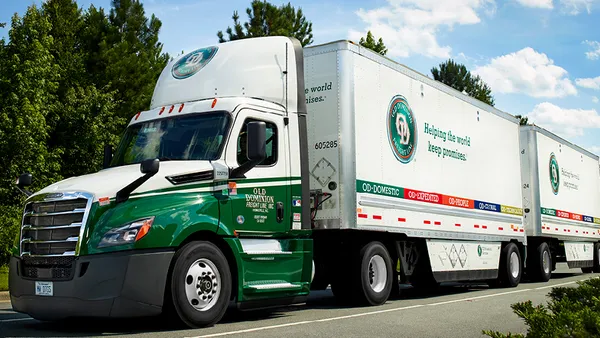Dive Brief:
- Capacity at the end of August was tight, and DAT principal analyst Dean Croke said carriers are telling him additional trucks won't be added until COVID-19 is better controlled. There were 1% fewer trucks searching loads on the DAT board, Croke told Transport Dive for the week ended Sunday.
- One of the reasons for the tight capacity was Hurricane Laura, Croke said in his post, with dry van outbound out of the Gulf Coast seeing rates jumped 7.3%, or up $0.14 per mile to $2.10 per mile. Reefer also tightened nationally, with 3% fewer trucks searching for loads, DAT said.
- Other analysts saw capacity tightening at the end of August, too. Truckstop.com's Market Demand Index hit an all-time high for the week ended Aug. 22 — comparing data going back to Jan. 1, 2014 — and the company noted the last time its index was comparably high was mid-summer in 2018. Truckstop.com officials also said spot rates were at levels last seen around Christmas 2018. Spot loads were up 4.3% week over week, while truck numbers dropped 2.8%.
Dive Insight:
As the summer ends, analysts are noting that capacity is tight and wondering when that will cease. Croke said in a webcast that capacity could be loosened if an important player in the economy slows down.
"My focus for the next few months is on consumer spending," Croke said during a DAT webcast. "Consumer spending accounts for about two-thirds of U.S. economic activity."
Croke is studying consumer packaging statistics, and is seeing goods in need of constant replenishment, like bacon, up 11% year over year, but down 6% from a June peak. Consumers are changing their spending habits, and volumes are high for goods that have a long shelf life, Croke told Transport Dive. The consumer-packaging numbers could indicate consumers are slowing down, and consumer confidence is likely going down, he said. One reason could be the lack of a new federal relief package.
"There's been a change in buying habits," Croke told Transport Dive, speaking of the last few weeks. "People are expressing concern about the pace of the economic recovery."
For now, trucks are still needed, and that is driving spot rates up. An August reading within the Logistics Managers' Index, a survey by the Council of Supply Chain Management Professionals, came in at 31.5 in August. The council's Transportation Capacity Index was down from the June reading of 42.8. A reading above 50 indicates expansion.
"This is the second-lowest score in the history of the LMI, indicating a significant contraction in available capacity," the report said. "Transportation Capacity will continue to be strained over the next 12 months, and that as a result, firms will have to utilize more of what is available."
The tightness is also demonstrated by Truckstop.com's index, which clocked in at 98.6 at the end of 2020's 34th week. That means there are roughly 98 times more loads available than there are trucks on Truckstop.com, according to Matt Stubbs, a Truckstop.com spokesperson. The average index is closer to 25 or 30, Stubbs said in an email.














